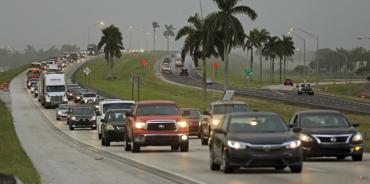
South Florida was placed under a hurricane warning and the remainder of Florida braced itself for Hurricane Irma’s fury as it continued its westward track Friday. Irma, a Category 4 storm, is expected to make landfall in Florida by Sunday morning.
Floridians began evacuating low-lying areas earlier this week, with many hitting the highways and heading out of the state as Irma made its way closer to the U.S., threatening to pound the Sunshine State with high-speed winds and intense rain.
Millions of travelers jammed highways and the Florida Turnpike, all trying to make an escape before the hurricane hits in 48 hours.
Packed roadways meant longer than usual travel times for evacuees, with trips to Atlanta taking as long as 18 hours due to heavy traffic on the Florida Turnpike and I-95.
Residents were urged to evacuate immediately as most shelters planned to close at midnight Friday. Though originally forecast to just miss the East Coast of Florida, Hurricane Irma is projected to make landfall in South Florida by Sunday, moving north up the entire state before making its way to Georgia and Tennessee.
The West Coast of Florida is now more directly in the storm’s path. Cities like St. Petersburg began mandatory evacuations Thursday.
A hurricane warning and watch extended from South Florida to the central part of the state, with maximum sustained wind speeds of 155 miles per hour.
“Irma is likely to make landfall in Florida as a dangerous major hurricane, and will bring life-threatening wind impacts to much of the state regardless of the exact track of the center,” the National Hurricane Center said Friday.
On top of brutal wind speeds and torrential rain, state officials also worried about the possibility of a high storm surge which could prove particularly dangerous to those in Irma’s path.
Storm surge is often strong enough to sweep cars away and is part of the reason Hurricanes Katrina and Sandy were so destructive when they struck in 2005 and in 2012.
Gov. Rick Scott warned Floridians to leave immediately if they were living in an evacuation zone, as the clock was running out.
“This is a life-threatening situation,” Scott said in a news briefing. “The storm surge will rush in, and it could kill you. Think about it, six to 12 feet (of storm surge). That is taller than some homes, and it’s going to rush in. You’re not going to survive this.”
Irma has already broken records for its wind speed and massive size, with hurricane force winds extending around 150 miles across the storm.
Gov. Scott ordered schools and universities across the state close their doors Friday through Monday in anticipation of the storm.
“Every family must prepare to evacuate,” he said.
The death toll from Hurricane Irma had already hit 23 after the storm ravaged the Caribbean, causing mass destruction on its path.
Irma has already drawn several comparisons to Hurricane Andrew, which hit South Florida and leveled portions of the state in 1992, killing 65 people.
The recovery from Andrew cost an estimated $26.5 billion -- around $50 billion with inflation. Irma is projected to be more catastrophic due to its much larger size and is moving slower than Andrew did when it zoomed across Florida in 1992.
Reach reporter Allison Nielsen by email at allison@sunshinestatenews.com or follow her on Twitter: @AllisonNielsen.
READ MORE FROM SUNSHINE STATE NEWS
Florida’s Municipal Electric Utilities, Power Plants in Full-Prep Mode for Irma


